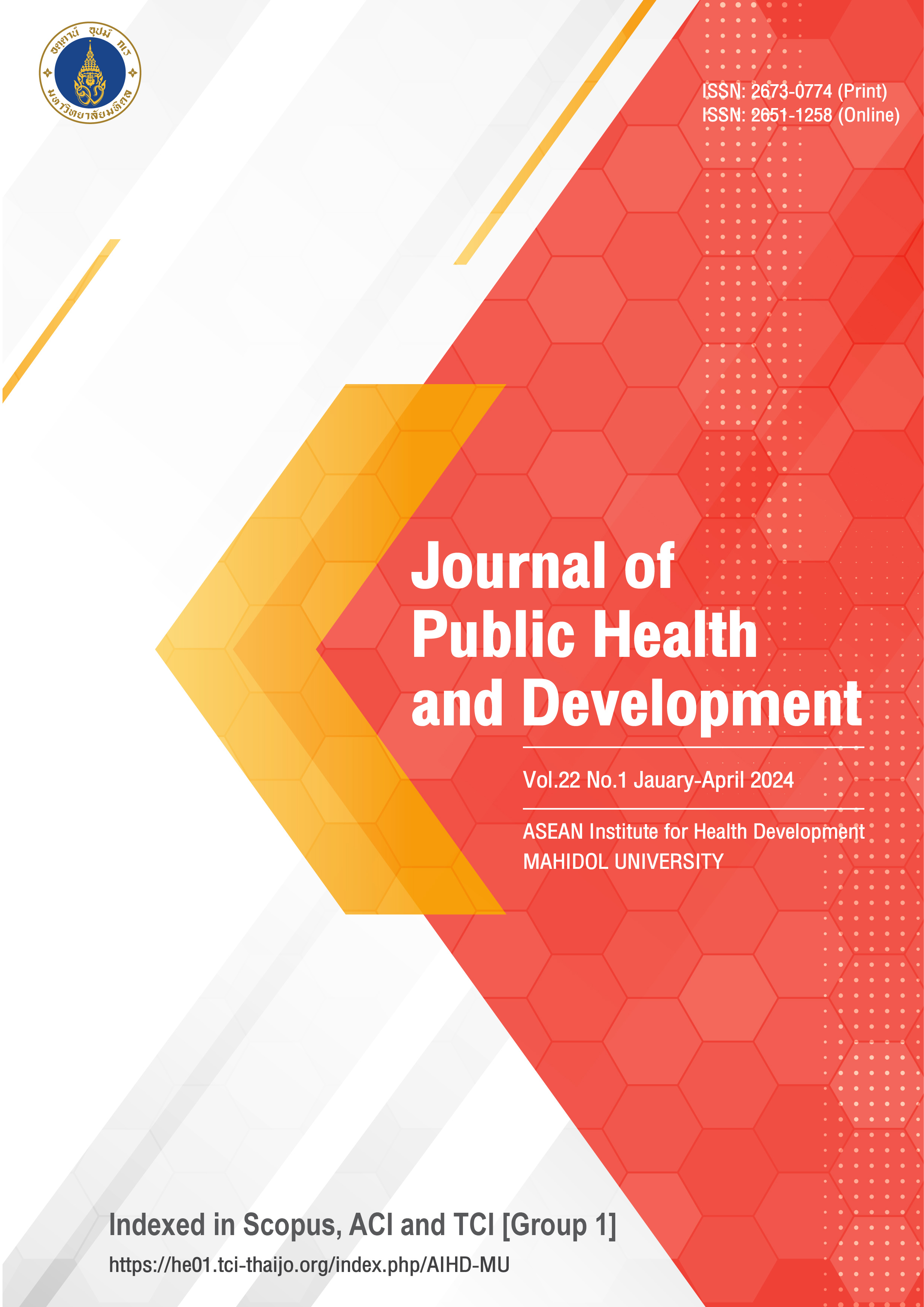Applying the concept of Thai nutrient profiling as a model for the Thai school lunch planner 10.55131/jphd/2024/220117
Main Article Content
Abstract
This study aimed to develop the Thai school lunch planning program using nutrient profiling (NP). The intention was to create a user-friendly tool that aids teachers in preparing nutritionally balanced school lunch menus. The Thai school lunch planner was developed by gathering 53 popular lunch menus from a school lunch outsourcing company in Bangkok. Menus were grouped into ten categories based on food characteristics and cooking methods. Then, menus were graded according to their energy and 13 nutrients using NP criteria as ‘grade A’ (score >16), ‘grade B’ (scores 12-16), and ‘grade C’ (score <12), and menu category codes were created. Lunch sets were matched across the menu category codes and based on the two formats of school lunch standards. Finally, lunch sets were graded based on energy and 13 nutrient contents using NP criteria, with cut-off macronutrients set at 30% of Thai DRI 2020. Regarding the two formats of school lunch standards, this study found 63 uniquely matched patterns, with the possibility of forming 5,160 lunch sets. Lunch pattern format 1 had 57 patterns and 5,085 menu sets, of which 2,706 menu sets met 30% of the Thai DRI macronutrient requirement. The lunch pattern format 2 could create up to 75 sets from six patterns. Thirty-seven menu sets (49.3%) met the 30% Thai DRI macronutrient requirement. NP could be a valuable alternative for planning school lunch sets to guarantee high-quality and nutritious meals. This technique can be combined with the existing school food menu guidelines. Teachers, with or without basic nutrition knowledge, can find this strategy relatively user-friendly. Even though this technique is suitable for primary schools that serve two side dishes, schools serving one side dish can apply it by increasing the portion of the side dish.
Article Details

This work is licensed under a Creative Commons Attribution-NonCommercial-NoDerivatives 4.0 International License.
References
Saavedra JM, Prentice AM. Nutrition in school-age children: a rationale for revisiting priorities. Nutr Rev. 2023;81(7):823-43. doi: 10.1093/ nutrit/nuac089.
World Health Organization. Food and nutrition policy for schools: a tool for the development of school nutrition programmes in the WHO European Region. Denmark: WHO Regional Office for Europe; 2006.
Bangkok Metropolitan Administration. The Education Office requests approval to improve guidelines regarding student expenses of schools in Bangkok Metropolitan Administration. Finance Department, Bangkok Metropolitan Administration; 2022.
Bangkok Metropolitan Administration. The public health activity report Fiscal year 2021. Health Department, Bangkok Metropolitan Administration; 2021.
Bangkok Metropolitan Administration, Health Department. The public health activity report Fiscal year 2022. Health Department, Bangkok Metropolitan Administration; 2022.
Hawkes C, Ruel MT, Salm L, Sinclair B, Branca F. Double-duty actions: seizing programme and policy opportunities to address malnutrition in all its forms. Lancet. 2020; 395 (10218):142-55. doi: 10.1016/S0140-6736(19)32506-1.
St-Onge MP, Keller KL, Heymsfield SB. Changes in childhood food consumption patterns: a cause for concern in light of increasing body weights. Am J Clin Nutr. 2003; 78(6):1068-73. doi: 10.1093/ajcn/78.6. 1068.
Simmala S. Administration of Student Lunch Project According to Good Governance Principles: A Case Study of Schools under Dusit District Office [Internet] [Master of Public Administration]. Ramkhamhaeng University. [cited 2023 Oct 06]. Available from: http://www3.ru.ac.th/ mpa-abstract/files/2562_1582279417_ 6114830029.pdf
Drewnowski A, Amanquah D, Gavin-Smith B. Perspective: How to Develop Nutrient Profiling Models Intended for Global Use: A Manual. Adv Nutr. 2021;12(3):609-20. doi: 10.1093/ advances/nmab018.
World Health Organization. Nutrient profiling: Report of a WHO/IASO technical meeting. 4-6 October 2010; London, United Kingdom. Switzerland; 2011.
Pongutta S, Sirichakwal P, Chittchana U, Puwastien P, Rojroongwasinkul N, Sranacharoenpong K, et al. Nutrient Profiling: a Tool to Strengthen Nutrition Intervention in Thailand. J Health Sci. 2015;24(5):1030-40.
Thailand, Mahidol University, Institute of Nutrition. Nutrients calculation software: INMUCAL-Nutrients V.4.0 Database version NB.4. 2018.
Changbumrung S, Mo-suwan L, Phonrat B, Suthutvoravut U, Udomkesmalee E, Chongviriyaphan N, et al, editors. Dietary Reference Intake Table for Thais 2020. Bureau of Nutrition, Department of Health, Ministry of Public Health; 2020.
Pimani K, Thaiboonrod A, Chittchang U, Banjong O. INMU-SchoolLunch Program manual. 1st rev. ed. Nakhonpathom. Institute of Nutrition, Mahidol University; 2010.
Ministry of Public Health. Announcement of the Ministry of Public Health (Issue 182) 1998, nutrition labeling. Ministry of Public Health; 1998.
Addison CC, Jenkins BW, White MS, Young L. Examination of the food and nutrient content of school lunch menus of two school districts in Mississippi. Int J Environ Res Public Health. 2006;3(3):278-85. doi: 10.3390/ijerph 2006030034.
Miyawaki A, Lee JS, Kobayashi Y. Impact of the school lunch program on overweight and obesity among junior high school students: a nationwide study in Japan. J Public Health (Oxf). 2019;41(2):362-70. doi: 10.1093/ pubmed/fdy095.
Hori K, Kim Y, Kim S, Thasanee W, Rahma Boedi PRA, Hu J, et al. Comparison of attitudes towards school lunch by elementary school children in Japan, Korea and Thailand. Int J Consum Stud. 2001;25(1):9-14. doi:10.1111/j.1470-6431.2001. 00139.x.
The NuVal Attribute Program. Val System [Internet]. [cited 2023 Dec 29]. Available from: http://www.nuval. com.
DrFuhrman. ANDI Food Scores: Rating the Nutrient Density of Foods [Internet]. [cited 2023 Dec 29]. Available from: https://www. drfuhrman.com/recipes/mealplans.
Epstein LH, Myers MD, Raynor HA, Saelens BE. Treatment of Pediatric Obesity. Pediatrics. 1998;101:554-70. doi: 10.1542/peds.101.S2.554
Morimoto K, Miyahara Kimiko. Nutritional Management Implemented at School Lunch Programs in Japan Based on the Changes in Criteria for Provision of School Lunches. Jpn. J. Nutr. Diet. 2018;76(1):23-37. doi: 10.5264/eiyogakuzash






